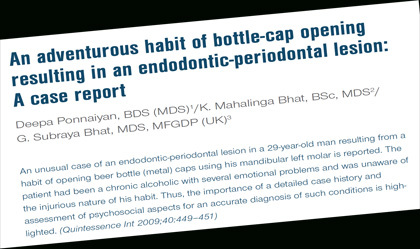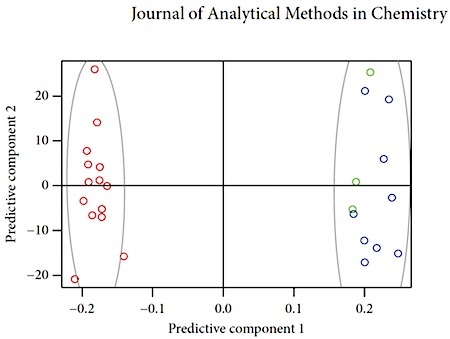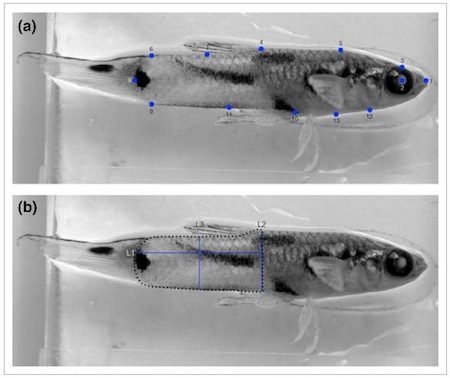Marc Abrahams's Blog, page 242
November 2, 2016
Podcast #88: The Tooth Fairy, Smelly Dental Floss, and a Swallowed Toothpick
A lost tooth turning up in a child’s ear, and other peculiar reports in dental journals chew up this week’s Improbable Research podcast.
SUBSCRIBE on Play.it, iTunes, or Spotify to get a new episode every week, free.
This week, Marc Abrahams teams up with Harvard chemist Daniel Rosenberg, who gives dramatic readings and opinions, drawing on his own dental experience, his knowledge of chemistry and physics, and — most of all —these published dental reports:
“The Tooth Fairy and Malpractice,” Sian Ludman, Hamid Daya, Polly S. Richards, and Adam Fox, BMJ, 2012, p. 345.
“The Odor Emitted From Dental Floss Used on Flossed and Non-Flossed Teeth for a One Week Time Period,” F.J. Ceravolo and A. Baumhammers, Periodontal Abstracts, vol. 21, no. 4, Winter 1973, pp. 155–8.
“Toothpick Perforation of a Colon Diverticulum: An Adjunct Autopsy Finding,” Glenn W. Wilcher, Medicine, Science and the Law, vol. 50, no. 3, July 2010, pp. 156–8.
“An Adventurous Habit of Bottle-Cap Opening Resulting in an Endodontic-Periodontal Lesion: A Case Report,” Deepa Ponnaiyan, K. Mahalinga Bhat, and G. Subraya Bhat, Quintessence International, vol. 40, no. 6, June 2009, pp. 449–51.
“Elevation of One Eye During Tooth Brushing,” Irene Gottlob, Sunila Jain, and Elizabeth C. Engle, American Journal of Ophthalmology, vol. 134, no. 3, September 2002, pp. 459–60.
“Extraction of a Grossly Decayed Tooth Without Local Anesthesia but with Audio Analgesia: A Case Report,” Manish Bhagania and Anirudha Agnihotry, Music and Medicine, vol. 3 no. 4, October 2011, pp. NP1–3. .
The mysterious John Schedler or the shadowy Bruce Petschek perhaps did the sound engineering this week.
The Improbable Research podcast is all about research that makes people LAUGH, then THINK — real research, about anything and everything, from everywhere —research that may be good or bad, important or trivial, valuable or worthless. CBS distributes it, on the CBS Play.it web site, and on iTunes and Spotify).

Brain Size and the Risk of Getting Shot
Some humans are always hunting for thoughts about their brains. Some humans are always hunting for birds. Sometimes, as in a newly published research study, these sometimes occurrences combine in provocative ways. The study is:
“Brain Size and the Risk of Getting Shot,” Anders Pape Møller, Johannes Erritzøe, Biology Letters, vol. 12, no. 11, November 2, 2016: 20160647.
The authors, at Université Paris-Saclay, France and at House of Bird Research, Denmark, explain:
“We hypothesized that hunted individuals differing from survivors by having better ability to distinguish between dangerous humans and other human beings would be at a selective advantage. We tested whether shot individual birds had smaller brains than survivors, under the assumption that individuals with larger brains had superior escape ability. We used a large database on birds from Denmark to test whether getting shot was predicted by brain mass, while controlling statistically for the potentially confounding effects of age, sex, body mass and body condition. Analyses based on all species, or only species that were hunted, while controlling for differences in sampling effort in random effects models, showed consistently that shot individuals had smaller brains than survivors.”
The researchers report a mass of conflicting results that can provoke delightedly heated arguments: “A total of 299 (7.9%) out of 3781 birds were shot. Among these 3781 birds, brain mass was on average 2.99 g (s.e. = 0.05), range 0.23–19.96 g, and body mass was 260.71 g (8.89), range 4.16–13 000 g. Whether an individual was shot or not was related to brain mass (individual birds with smaller brains being shot more often), body mass (larger individuals being shot more often) and sex (higher probability in males)…
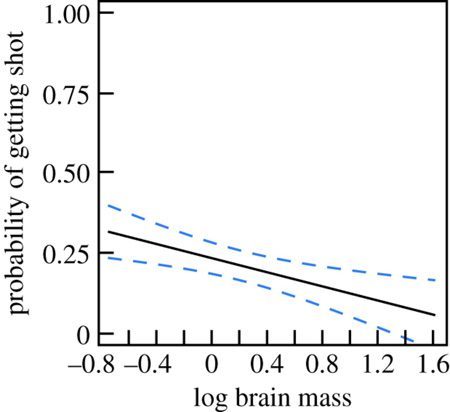
The researchers also report on their own ethics: “This study required no ethical permit, because all data were retrieved from the professional activities of J.E., a professional taxidermist. All specimens were dead when he received them, and they were supplied by his customers.”
(Thanks to Berry Pinshow for bringing this to our attention.)
BONUS: A January, 2007 report, by Brandan Borrell, in The Scientist Magazine, about the lead author of this study:
A Fluctuating Reality
A Fluctuating Reality Accused of fraud, Anders Pape Möller has traveled from superstar evolutionary biologist to pariah….

November 1, 2016
An ambiguous abbreviation of a journal title: “J Anal Methods Chem”
The PubMed database abbreviates the names of many research journals. Sometimes these abbreviations lend themselves to confusion. Sometimes that confusion can, maybe, be willful. Here’s an example, in a citation of a chemistry study:
Classification of Coffee Beans by GC-C-IRMS, GC-MS, and (1)H-NMR.
J Anal Methods Chem. 2016;2016:8564584
Authors: Arana VA, Medina J, Esseiva P, Pazos D, Wist J
You may wish to track down the full, non-abbreviated citation. The authors are based in Colombia and Switzerland. They say that their goal, in doing the study, is to report new “encouraging steps towards the construction of a robust expert system for the discrimination of coffees from Colombia versus nearby countries (Brazil and Peru).” Here’s further detail:

October 31, 2016
The Bureaucracy Club Endures
The Bureaucracy Club is an organization of bureaucrats, by bureaucrats, for bureaucrats.
The Bureaucracy Club is dedicated to the propagation, study, maintenance, enhancement, documentation, and optimization of bureaucracies and bureaucrats.
After many years of bureaucratic quietude, The Bureaucracy Club is rousing itself to accept new applications for membership.
LACK OF DETAILS is available at the Bureaucracy Club web site.

Unresolvable human mental states (based on a parallel universe theory)
“A mental state with respect to a situation composed by multiplying two situations equals the sum of mental states for each situation. A mental state with respect to a situation composed by dividing two situations equals the difference between mental states for each situation.”
So explain professor Changsoo Shin and colleagues at the Department of Energy Systems Engineering, of Seoul National University, South Korea. The team employ Heaviside step functions (θ) applied to parallel universe theories to explain why each person has different thoughts in a particular situation – for example in a situation such as when Jane, Paul, and Bill met a stray dog when they were out walking together – see table 2 below.
“Jane showed no interest in the dog because she has no meaningful experience related to a dog. Paul said that the dog is cute because he grew up with several pet dogs. On the other hand, Bill tried to stay away from the dog because a stray dog had bitten him during childhood.”
The paper also applies θ to explain remembering and forgetting – for full details See: ‘Unresolvable human mental states based on a parallel universe theory’ in: arXiv Journal-ref: Advancement and Developments in Applied Mathematics 1 (2012) 18-29.
Also see, from professor Shin : Is God dead? – the math(s)

October 30, 2016
The Biology of B-Movie Monsters
Michael C. LaBarbera some years ago applied his loving knowledge of biology to his knowledgeable love of monster movies. The result:
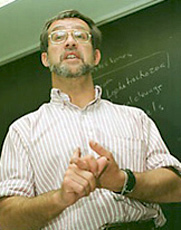 “The Biology of B-Movie Monsters,” Michael C. LaBarbera [pictured here], Fathom, 2003. It begins thus:
“The Biology of B-Movie Monsters,” Michael C. LaBarbera [pictured here], Fathom, 2003. It begins thus:
SESSION 1: Biology and Geometry Collide!
Size has been one of the most popular themes in monster movies, especially those from my favorite era, the 1950s. The premise is invariably to take something out of its usual context–make people small or something else (gorillas, grasshoppers, amoebae, etc.) large–and then play with the consequences. However, Hollywood’s approach to the concept has been, from a biologist’s perspective, hopelessly naïve. Absolute size cannot be treated in isolation; size per se affects almost every aspect of an organism’s biology. Indeed, the effects of size on biology are sufficiently pervasive and the study of these effects sufficiently rich in biological insight that the field has earned a name of its own: “scaling.” …
BONUS: The classic of classics on the underlying science: D’Arcy Thompson‘s Growth and Form

October 29, 2016
The special RED issue of the magazine is out
The special RED issue (vol. 22, no. 5) of the magazine (the Annals of Improbable Research) is now out! It’s bursting (as are all our issues) with carefully culled, improbable research snippets about everything, from anywhere, more or less.
Click on the cover image, below, to see the table of contents and some of the articles.
The special RED section includes these articles:
Women and Men on Men and Women in Red
The Power of Red Pens, Red-Clad Politicians, and Red Sneakers
Guéguen on Red
Some Insect Responses to Red
Sometimes When Women Wear Red
The Case of the Red Lingerie
Assessing the Effect of Magnets on Cheap Red Wine
Confessions of a Colour Blind Optometrist
Kissing At a Distance
If you are a subscriber, you should have received an email letting you know the new issue is available, with directions for downloading your copy.
If you are not yet a subscriber, you can purchase that issue —or subscribe!—on our Gumroad page.
Back issues of the magazine, and tables of contents, are available here on the Improbable website.
Special thanks to Lauren Maurer Trew, our bookmaster, for working much of the tech magic that brought the magazine into this new, PDF era.

October 28, 2016
Fluid Dynamics and the Potential Cost of Long Genitalia in Male Guppies
Male guppies with long genitals may swagger, physically in a current, and metaphorically in the grand scheme of reproduction. Or not. This newly published study explores these questions:
“A Potential Cost of Long Genitalia in Male Guppies: the Effects of Current Speed on Reproductive Behaviour,” Lucia Kwan, Adam N. Dobkin, F. Helen Rodd, and Locke Rowe, Ethology, epub October 13, 2016. The authors explain:
“genital elongation may come at a cost of reduced locomotor abilities (e.g. resulting from greater drag and resistance). In this study, we were interested in the potential role of natural selection on the evolution of gonopodium length in poeciliids. Specifically, we asked whether a greater genital length impedes male reproductive behaviours at higher flow rates in the Trinidadian guppy, Poecilia reticulata. Using a flow chamber, males were placed with females in low- and high-flow regimes and reproductive behaviours were measured. We did not find evidence for a cost of bearing a longer gonopodium at high flow. However, males did alter their mating tactics in response to current flow.”
(Thanks to Sara Lewis for bringing this to our attention.)

October 27, 2016
Is God dead? – the math(s)
 Friedrich Nietzsche [pictured] caused a considerable stir in 1882 when he pronounced (via his book Die fröhliche Wissenschaft) that “God is dead”. Since then, a great number of philosophers and theologians have analysed his provocative statement – but not all that many mathematicians. One exception is Changsoo Shin who is a professor at the Department of Energy Systems Engineering and faculty member of the SNU Geophysical Prospecting Lab at Seoul National University, South Korea. He turns to Heaviside step functions for answers :
Friedrich Nietzsche [pictured] caused a considerable stir in 1882 when he pronounced (via his book Die fröhliche Wissenschaft) that “God is dead”. Since then, a great number of philosophers and theologians have analysed his provocative statement – but not all that many mathematicians. One exception is Changsoo Shin who is a professor at the Department of Energy Systems Engineering and faculty member of the SNU Geophysical Prospecting Lab at Seoul National University, South Korea. He turns to Heaviside step functions for answers :
“The paper argues that the ultra-unconscious being (God or a supernatural being) can be expressed using the infinite recursive Heaviside step function, and assumes it as the God’s potential. The sumption [sic] is that differentiation of the potential with respect to time is the process of becoming conscious, and in a world where only time exists, the energy produced thereafter became a highly dense Cosmic Egg.”
And with regard to the death (or otherwise) of God :
“It seems, however, that God did not go through another process of becoming conscious since the birth of the universe. An enormous amount of energy would have been produced if there was another unconscious-to-conscious transforming process, and the universe would have collapsed. In this sense, Friedrich Nietzsche’s famous statement that the God is dead might hold some truth. God created the universe, but did not further work on it.”
His paper ‘God before the big bang’ is published in the International Education & Research Journal* vol. 2, Issue. 4, 53-55 – and can be read in full here:
Bonus: God Is Dead? By Black Sabbath
Image Credit: The drawing of Nietzsche above is by Hans Olde
(c. 1899) and shows, in considerable detail, his prolific walrus-handlebar moustache.
*Note: Not everyone is in agreement regarding the academic standing of the International Education & Research Journal, appearing, as it does, on Jeffrey Beall’s list of “potential, possible, or probable predatory scholarly open-access journals”
Coming soon: The professor investigates why each person has different thoughts in a particular situation, and uses Heaviside step functions to explain remembering and forgetting.

October 26, 2016
Podcast 87: How kids learn to say “Trick or Treat!”
Jean Berko Gleason explains how kids learn to say “Trick or Treat!” —and how it helps them stride down the road to adulthood. That’s the story in this week’s Improbable Research podcast.
NOTE (October 26, 7:00 pm): There’s a technical glitch in the podcast widget (good heavens!). We will get it fixed. Meanwhile you can hear all the Improbable Research podcasts, on the Play.it site.
SUBSCRIBE on Play.it, iTunes, or Spotify to get a new episode every week, free.
This week, Marc Abrahams discusses “Trick or treat!” with Boston University psychology professor emerita Jean Berko Gleason. Early in her career, Gleason gained fame for inventing the WUG Test. The WUG test revealed that young children have impressively subtle abilities to learn — and use — new bits of language. The trick-or-treat study she did years later is only slightly less famous among psychologists.
The trick-or-treat study: “The Acquisition of Routines in Child Language,” Jean Berko Gleason and Sandra Weintraub, Language in Society, vol. 5, no. 2, August 1976, pp. 129-36.
Bela Lugosi as Dracula .
Here’s a photo of Professor Gleason wearing a costume:

The mysterious John Schedler or the shadowy Bruce Petschek perhaps did the sound engineering this week.
The Improbable Research podcast is all about research that makes people LAUGH, then THINK — real research, about anything and everything, from everywhere —research that may be good or bad, important or trivial, valuable or worthless. CBS distributes it, on the CBS Play.it web site, and on iTunes and Spotify).

Marc Abrahams's Blog
- Marc Abrahams's profile
- 14 followers


